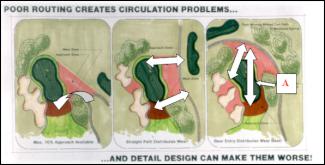Featured Golf News
Warren Spots asks, How can you avoid poor turf around greens?
Concentrated foot and cart traffic hurts turf, especially if combined with poor growing conditions. Good turf really starts by selecting green sites with adequate sunlight, air circulation and drainage. It continues with modifying green sites by clearing trees and brush:
to a distance equal to their mature height east and south of the green for sunlight;
in the direction of prevailing winds to allow air circulation;
to mature canopy width from the green, avoiding root competition for moisture; and
in major circulation areas, forcing golfers to either side, concentrating traffic.
It also means grading the site to allow adequate drainage, including diverting all uphill drainage well away from the green and its access points. If subsurface springs are present, these should also be piped. During construction, the contractor must save adequate amounts of the best topsoil as a growing medium for high-traffic areas.
The green complex (which is a term for the all the integrated components of a green green, bunkers, slopes, etc., and not a psychological condition affecting golf course architects must have ample circulation area between the putting surface and cart path. A good rule of thumb* is to provide approximately 2 feet of entry width for every 1,000 rounds of play to adequately distribute foot traffic (i.e. 80 feet for 40,000 rounds) and to keep the path 45-60 feet from the green.
This entry should be relatively level, without impediments, and designed to avoid funneling golfers to "cow paths." It's easy enough to plot the "natural progression" of golfers. If the next tee is to the right, most golfers will go right. They will ALWAYS take the shortest and most level route from the cart to their ball.
Golfers will walk around even the smallest obstacles, funneling traffic, and eventually wearing out turf. The arrangement of path, hazards and greens must provide 80 or more feet of nearly equal access, avoiding blocking those natural routes with bunkers, mounds, etc. as shown in this sketch:
The first sketch demonstrates that a "walk-back" routing naturally limits access points. It also shows that any mound in the desired walkway will cause wear at its toe of slope.
The middle sketch shows a wide, flat area covering the entire ground between cart path and green. Any bunker or mound in the pink area would funnel traffic flow. The last green moves the access area to the back of the green, which speeds play, but requires other considerations.
If the third sketch had mounding at point A, most golfers would walk around it, near the green edge to "protect" the green, inadvertently causing a wear area on the fringe. Moving the mounds forward allows "straight-line" access from the path to all pin areas. The path is closer to the green at the rear, encouraging golfers to drive further for a shorter walk, especially when the pin is in the rear. Some will stop just past the mound, especially when the pin is near the front, naturally distributing exit points.
Other design attributes to keep green surrounds in good turf include simple green shapes with 48 feet minimum diameter lobes to reduce mowing stress, preferably with the widest part of the green fronting the cart path to naturally widen the walk-up area, and avoiding severe green contours in the primary walk-up area.
A good golf course architect is sensitive to how design affects maintenance. The next time you complain to your superintendent about turf conditions near a green, you should consider whether the architect left him/her with a "designed-in" problem.
* I didn't say R.O.B.O.T. because I don't often break this rule.
Story Options
 |
Print this Story |
